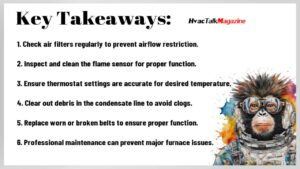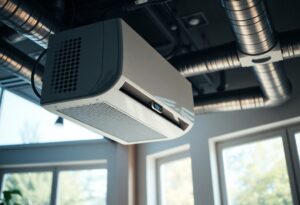Top 10 Furnace Problems and How to Fix Them
As the temperature drops, your furnace becomes your best friend until it breaks down, leaving you shivering in the cold. Don’t let a faulty furnace ruin your winter. In this article, you’ll learn how to identify and fix the top 10 furnace problems, from faulty igniters to clogged filters. With these practical tips, you’ll be able to diagnose and repair your furnace like a pro, saving you time, money, and the hassle of calling in a professional. So, let’s get started and keep your home warm and cozy all winter long!
Key Takeaways:
Here are the top 7 key takeaways about the top 10 furnace problems and how to fix them:
- Clogged Air Filters are a common issue that can reduce furnace efficiency and increase energy bills. Regularly cleaning or replacing air filters can resolve this problem.
- Thermostat Malfunctions can cause the furnace to malfunction or not turn on at all. Check the thermostat’s battery, settings, and wiring to ensure it’s working correctly.
- Ignition Issues can prevent the furnace from igniting, often due to a faulty ignition sensor or a faulty gas valve. Cleaning or replacing these components can resolve the issue.
- Furnace Not Blowing Air can be caused by a faulty blower motor or clogged air ducts. Checking and cleaning the air ducts, as well as replacing the blower motor if necessary, can fix this problem.
- Leaks and Water Damage can occur due to a faulty condensate drain or rusted furnace components. Regular maintenance and inspections can help prevent these issues.
- Furnace Not Heating can be caused by a variety of factors, including faulty heating elements, thermostat issues, or low gas supply. Identifying and addressing the root cause can resolve the issue.
- Regular Maintenance is key to preventing many common furnace problems. Scheduling annual tune-ups and inspections can help extend the lifespan of the furnace and reduce repair costs.
Top 7 Furnace Problems
For a furnace to function efficiently, it’s necessary to identify and address common problems that can arise. In this section, we’ll explore some of the most frequent issues you may encounter with your furnace.
1 Ignition Problems
A faulty ignition system can prevent your furnace from producing heat. If you notice that your furnace is not igniting, check the ignition sensor, pilot light, or hot surface igniter for any signs of damage or malfunction.
2 Faulty Thermostats
One of the most common furnace issues is a faulty thermostat. If your thermostat is not functioning correctly, it can cause your furnace to malfunction or not turn on at all.
Another issue with faulty thermostats is that they can cause your furnace to work inefficiently, leading to increased energy bills and reduced heat output. Make sure to check your thermostat’s battery level, settings, and wiring for any signs of damage or malfunction.
3 Dirty or Clogged Air Filters
The air filter in your furnace plays a crucial role in maintaining good air quality and ensuring efficient heat production. If your air filter is dirty or clogged, it can reduce airflow, causing your furnace to work harder and increase energy bills.
To avoid this issue, make sure to replace your air filter every 1-3 months, depending on usage and the manufacturer’s recommendations. A clean air filter can help improve your furnace’s performance, reduce energy bills, and extend its lifespan.
4 Electrical and Gas-Related Problems
Little do homeowners know, that electrical and gas-related issues can be the most critical problems to tackle when it comes to furnace maintenance. In this section, we’ll explore the top electrical and gas-related problems that can affect your furnace’s performance and provide you with actionable tips to fix them.
Tripped Circuit Breakers
For your furnace to function properly, it needs a steady supply of power. If your circuit breaker trips frequently, it may be a sign of an electrical issue. Check your circuit breaker panel to ensure that the breaker hasn’t tripped due to an overload or short circuit. Reset the breaker or replace the fuse to get your furnace up and running again.
Loose or Faulty Wiring
Gas-related issues can be hazardous, but electrical problems can be just as dangerous. Loose or faulty wiring can cause your furnace to malfunction or even start a fire. Inspect your wiring for signs of wear or damage and tighten any loose connections to prevent electrical shocks or fires.
A more in-depth inspection of your wiring can reveal underlying issues that may not be immediately apparent. Check for frayed cords, exposed wires, or rusted terminals, and replace them promptly to ensure your furnace operates safely and efficiently.
5 Gas Leaks or Odors
To ensure your safety, it’s necessary to address any gas leaks or odors immediately. If you smell gas or suspect a leak, turn off the gas supply to your furnace and ventilate the area. Do not attempt to repair the leak yourself; instead, call a professional to inspect and fix the issue.
Odors from your furnace can be a sign of a more significant problem, such as a gas leak or carbon monoxide buildup. If you notice an unusual smell, don’t ignore it. Investigate the source of the odor and take prompt action to address it. Recall, your safety is paramount, so always err on the side of caution when dealing with gas-related issues.
6 Performance and Efficiency Issues
Many furnace problems can be attributed to performance and efficiency issues that can lead to discomfort, safety hazards, and increased energy bills.
Inconsistent Heating
Performance-wise, inconsistent heating is a common issue that can leave you feeling chilly in certain areas of your home. This problem often arises when your furnace is not properly sized for your space or if there are leaks in your ductwork. Check your ducts for gaps or cracks and consider upgrading to a furnace that better suits your home’s heating needs.
7 Loud or Unusual Noises
With a properly functioning furnace, you shouldn’t hear any unusual sounds. However, if you notice loud banging, rattling, or screeching noises, it may indicate a problem with your blower motor or ignition system.
Unusual noises can be a sign of a more serious issue, such as a cracked heat exchanger, which can lead to carbon monoxide poisoning. If you hear any unusual sounds, turn off your furnace immediately and contact a professional to inspect and repair it.
8 High Energy Bills
Efficiency-wise, high energy bills can be a significant concern. If your furnace is not running efficiently, it can cause your energy bills to skyrocket. Check your filter regularly and replace it every 1-3 months to ensure proper airflow and reduce energy consumption.
To optimize your furnace’s efficiency, consider upgrading to a high-efficiency model with a high AFUE rating. Additionally, regular maintenance, such as cleaning and inspecting your furnace, can help improve its performance and reduce energy bills. By addressing these performance and efficiency issues, you can enjoy a warmer, safer, and more cost-effective home.
9 Maintenance and Repair Tips
Now that you’re aware of the common furnace problems, it’s important to take proactive steps to prevent them from occurring in the first place. By following these maintenance and repair tips, you can ensure your furnace runs efficiently and safely throughout the winter season.
Here are some important tips to keep in mind:
- Regular cleaning and inspection to identify potential issues before they become major problems.
- Replacing air filters and spark plugs to ensure proper airflow and ignition.
- Scheduling professional maintenance to catch any underlying issues that may require expert attention.
Regular Cleaning and Inspection
Maintenance is key to extending the life of your furnace. Regularly clean your furnace’s air vents, blower, and burners to remove dust and debris that can reduce efficiency and increase the risk of breakdowns. Additionally, inspect your furnace’s electrical connections, gas lines, and heat exchangers for signs of wear or damage.
Replacing Air Filters and Spark Plugs
Repair and maintenance go hand-in-hand. Replacing your furnace’s air filters every 1-3 months and spark plugs annually can significantly improve its performance and reduce energy bills.
With dirty air filters, your furnace has to work harder to circulate air, leading to increased energy consumption and wear on the system. Similarly, worn-out spark plugs can cause ignition issues, resulting in reduced efficiency and potentially even carbon monoxide leaks.
10 Scheduling Professional Maintenance
With regular professional maintenance, you can identify potential issues before they become major problems. A licensed HVAC technician can inspect your furnace, clean or replace parts as needed, and provide recommendations for improvement.
Another benefit of scheduling professional maintenance is that it can help you avoid costly repairs down the line. By catching issues early, you can prevent minor problems from escalating into major breakdowns that can leave you without heat during the coldest months of the year. Thou shalt not neglect thy furnace maintenance!
Tip of the Day
Upgrade your home’s comfort with the best heating and cooling HVAC systems! Discover top-rated, energy-efficient solutions for perfect year-round climate control.
👉 Shop now and find the ideal HVAC system for your home. Experience unparalleled comfort and efficiency today!
To wrap up
Conclusively, you now possess the knowledge to tackle the top 10 furnace problems that can leave you shivering in the cold. By following the simple yet effective solutions outlined in this guide, you’ll be able to identify and fix the top 10 problems, saving you time, money, and frustration. Recall, being proactive about your furnace maintenance is key to ensuring your home remains warm and cozy throughout the year. Take control of your heating system, and you’ll be enjoying a comfortable living space in no time.
Top 10 Furnace Problems: FAQ
Q: What is the most common furnace problem and how can I fix it?
A: The most common furnace problem is a dirty or clogged air filter, which can reduce airflow and efficiency. To fix this, simply replace the air filter with a new one every 1-3 months, depending on usage and the manufacturer’s instructions. Make sure to turn off the power to the furnace before replacing the filter to avoid any electrical shock.
Q: Why is my furnace not producing heat, and how can I troubleshoot the issue?
A: If your furnace is not producing heat, it could be due to a variety of reasons such as a faulty thermostat, tripped circuit breaker, or faulty igniter. To troubleshoot, first check the thermostat to ensure it’s set correctly and functioning properly. Next, check the circuit breaker or fuse box to ensure the breaker hasn’t tripped or a fuse hasn’t blown. Finally, check the igniter to see if it’s dirty or faulty, and clean or replace it as needed.
Q: What causes a furnace to make strange noises, and how can I fix it?
A: Strange noises from a furnace can be caused by a variety of factors such as loose belts, dirty or clogged burners, or faulty inducer motors. To fix this, first check the belts and tighten or replace them as needed. Next, clean or replace the burners to ensure proper combustion. Finally, check the inducer motor and replace it if necessary. If the noise persists, it’s recommended to call a professional HVAC technician for further assistance.
Q: Why is my furnace not turning off, and how can I fix it?
A: If your furnace is not turning off, it could be due to a faulty thermostat, stuck relay, or faulty limit switch. To fix this, first check the thermostat to ensure it’s set correctly and functioning properly. Next, check the relay to see if it’s stuck and clean or replace it as needed. Finally, check the limit switch to ensure it’s functioning properly and replace it if necessary. If the issue persists, it’s recommended to call a professional HVAC technician for further assistance.
Q: What causes a furnace to leak water, and how can I fix it?
A: A furnace can leak water due to a clogged condensate drain line, faulty condensate pump, or high humidity. To fix this, first check the condensate drain line to ensure it’s not clogged and clean or replace it as needed. Next, check the condensate pump to ensure it’s functioning properly and replace it if necessary. Finally, check the humidity levels in your home and consider using a dehumidifier to reduce moisture.
Q: Why is my furnace not heating my home evenly, and how can I fix it?
A: Uneven heating can be caused by a variety of factors such as dirty or clogged air ducts, faulty zone valves, or improper furnace sizing. To fix this, first check the air ducts to ensure they’re clean and not clogged, and clean or replace them as needed. Next, check the zone valves to ensure they’re functioning properly, or replace them if necessary. Finally, consider having your furnace resized or replaced if it’s not suitable for your home’s heating needs.
Q: How can I prevent furnace problems from occurring in the first place?
A: To prevent furnace problems, it’s recommended to perform regular maintenance such as changing the air filter every 1-3 months, cleaning the burners and igniter annually, and having your furnace inspected and serviced by a professional HVAC technician every year. Additionally, consider installing a programmable thermostat to optimize your furnace’s performance and efficiency.
Learn more and join our mailing list for updates.
Follow Us on Google Chrome
To get started, switch to Google Chrome Browser
1. Already on our site
2. Top right, tap the 3 dots
3. Bottom right, tap follow
4. You are done.
This post has been written by Team HVAC Talk Magazine. Stay informed and connected with the latest in HVAC—join us for expert advice, troubleshooting tips, and news updates. Don’t miss out, follow us now! #HVACExperts #HVACTips #StayInformed #HVACProTalk!











